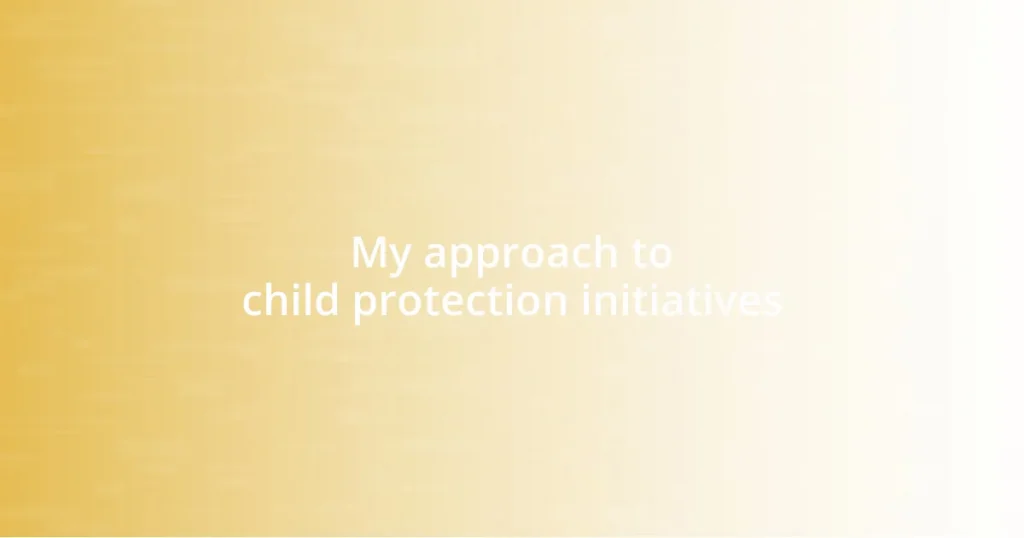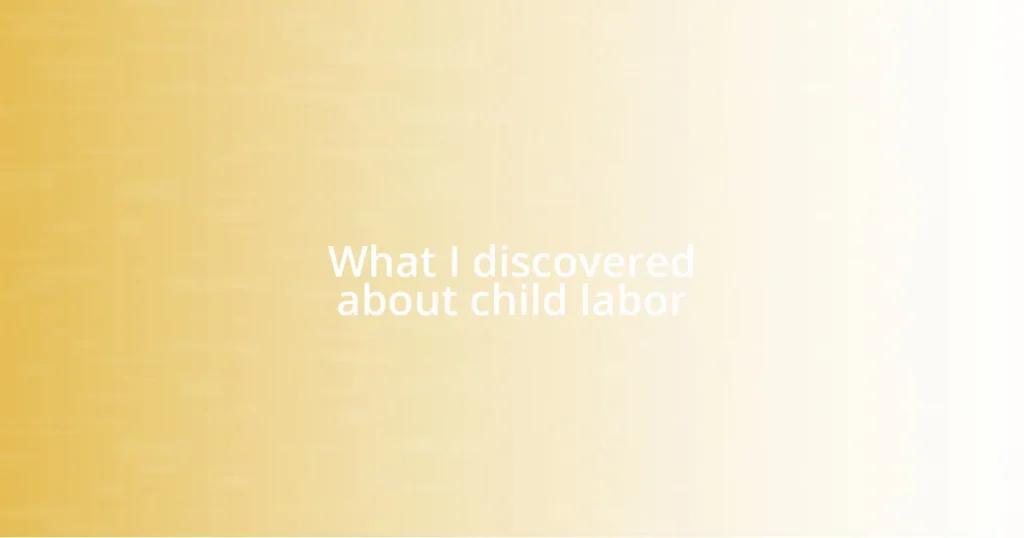Key takeaways:
- Child protection initiatives are essential for safeguarding children, requiring constant vigilance and effective communication among caregivers, educators, and social services.
- Community involvement is crucial, as it fosters trust, facilitates resource sharing, and encourages early identification of risks.
- Building partnerships with organizations enhances child protection efforts, utilizing combined resources and expertise for greater impact.
- Continuous monitoring and evaluation of initiatives, along with open communication and data analytics, are vital for adapting strategies to effectively protect children.

Understanding child protection initiatives
Child protection initiatives are designed to safeguard children from abuse, neglect, and exploitation. I recall a community event I attended where local leaders shared heartwarming stories about how these initiatives have changed children’s lives. It was a powerful reminder of the significant role we all play in creating safe environments for the most vulnerable among us.
When I think about child protection, I often wonder, what happens when these initiatives fall short? I remember a case I encountered where a child had repeatedly fallen through the cracks of the system. It underscored the importance of constant vigilance and effective communication between caregivers, educators, and social services.
The beauty of effective child protection initiatives lies in their multifaceted approach. They combine education, advocacy, and community involvement to build a robust safety net for our youth. I’ve seen firsthand how community workshops can equip parents with knowledge and skills, empowering them to recognize and address threats before they escalate. Isn’t it our collective responsibility to ensure that every child grows up in a safe, nurturing environment?

Importance of community involvement
Community involvement is vital in child protection initiatives. When I participated in a local outreach program, it struck me how a united community can create a protective shield around children. Everyone, whether a neighbor or a school coach, plays a crucial role in recognizing signs of distress or abuse. It made me realize that the more eyes and ears we have on the ground, the better we can keep our children safe.
Here are some reasons why community involvement matters:
- Trust Building: Strong community ties foster trust between families and local services, making it easier for individuals to seek help.
- Resource Sharing: Communities often have unique resources, like local expertise or networks, that can be leveraged for better child protection support.
- Civic Responsibility: Engaging the community creates a shared sense of responsibility, where everyone feels empowered to act for the wellbeing of children.
- Preventive Action: Active community members can identify risks early on, enabling preventive action before situations escalate.
In my experience, listening to parents share their concerns during community meetings often revealed underlying issues that needed addressing. It was a reminder that we cannot underestimate the power of a collective voice advocating for child safety.

Effective strategies for engagement
Engaging effectively in child protection initiatives requires fostering genuine relationships across various stakeholders. I remember conducting a workshop for parents and teachers, where we discussed real-life scenarios involving child safety. By sharing stories, we built trust and rapport, allowing participants to express their concerns more candidly. Isn’t it fascinating how such dialogues can unveil hidden challenges and solutions?
Another strategy I’ve found invaluable is interactive community events. Organizing family fun days, where children and their parents engage in games and activities, creates a fun atmosphere for open conversations about safety. During one such event, a young girl shared how she learned to seek help when encountering trouble, showcasing the power of a safe, engaging environment to empower children and affirm their voices.
Collaboration with local organizations also enhances engagement efforts. In my experience, partnering with youth centers or schools allows for resource sharing and a unified approach to outreach. I remember the success of a joint initiative that involved local artists raising awareness through murals depicting child safety messages. This creative angle not only decorated our neighborhood but also ignited meaningful conversations among families about child protection.
| Strategy | Description |
|---|---|
| Workshops | Interactive sessions that foster trust and address specific concerns. |
| Community Events | Fun activities that create a relaxed atmosphere for discussing safety. |
| Partnerships | Collaboration with local organizations for resource sharing and outreach. |

Building partnerships with organizations
Building partnerships with organizations can dramatically enhance the effectiveness of child protection initiatives. In my journey, collaborating with local non-profits has been incredibly rewarding. I recall a specific partnership with a children’s advocacy group where we conducted training for volunteers; it was inspiring to see their dedication and how much we could accomplish together when pooling our resources and expertise.
One of the most impactful experiences stemmed from working alongside a local health organization. They had valuable data and resources at their disposal that we could use to identify at-risk families. It was during a joint awareness campaign when I witnessed firsthand how our combined efforts turned into a safety net for children in need. Isn’t it astounding how organizations can amplify each other’s strengths?
Moreover, engaging businesses in our initiatives has proven fruitful, too. For instance, a local bookstore hosted a reading event focusing on themes of safety and respect. Seeing families come together in such a warm and supportive environment brought me immense joy and reinforced the idea that when organizations unite for a common cause, we truly create a stronger community. This holistic approach not only raises awareness but also reinforces a shared commitment to protect our children.

Creating educational programs for parents
Creating educational programs for parents is essential for fostering awareness and proactive engagement in child protection. I remember developing a series of parenting classes that tackled not just the basics of safety, but also the emotional tug-of-war many parents feel when discussing sensitive issues with their children. It was heartwarming to see parents share their fears and uncertainties, realizing they weren’t alone in this journey. Have you ever felt the pressure of raising a child in today’s world? Those conversations were eye-opening for all of us.
I also believe in tailoring programs to meet the diverse needs of families. For example, I once organized a seminar specifically for single parents, addressing unique challenges they face. They expressed how overwhelming it can be to balance work, responsibilities, and ensuring their child’s safety. It was deeply moving to see the relief on their faces when they learned practical strategies to create safe environments without the additional burden. Isn’t that what we all strive for—a sense of community where resources and knowledge flow freely?
Moreover, I’ve found that using real-life stories can be a powerful tool in educational settings. During one session, a parent shared a personal incident that involved their child and online safety. The vulnerability in their voice fostered an atmosphere of trust and connection among all the attendees. Such moments remind me that educational programs aren’t just about information; they’re about creating a support network that empowers parents to take charge of their children’s safety. How valuable would it be if every parent felt equipped and supported in navigating these challenges?

Monitoring and evaluating outcomes
Monitoring the outcomes of child protection initiatives is critical to ensure we are making meaningful progress. In my experience, I’ve learned that simply implementing a program is not enough; we must continuously measure its impact. For instance, during one project, we set up regular surveys to gather feedback from families involved. The results were often surprising, revealing areas we could improve. Have you ever realized that sometimes the smallest tweaks can lead to significant changes?
Another aspect I emphasize is the importance of maintaining open lines of communication. I once participated in a focus group that routinely met with service users to discuss their experiences. Hearing their stories firsthand was truly enlightening. They provided insights that we, as professionals, often overlook. It took me back to the heart of our mission: protecting children is a collaborative effort, and those on the frontlines hold valuable perspectives we must consider.
Finally, I can’t stress enough how utilizing data analytics can sharpen our approach. In a previous initiative, we analyzed demographic data to pinpoint which neighborhoods faced the highest risk levels. This targeted strategy allowed us to allocate resources more effectively. Reflecting on this experience, I often think about how crucial it is to adapt our methods based on real evidence. Isn’t it empowering to use data-driven decisions to advocate for those who need it most?















